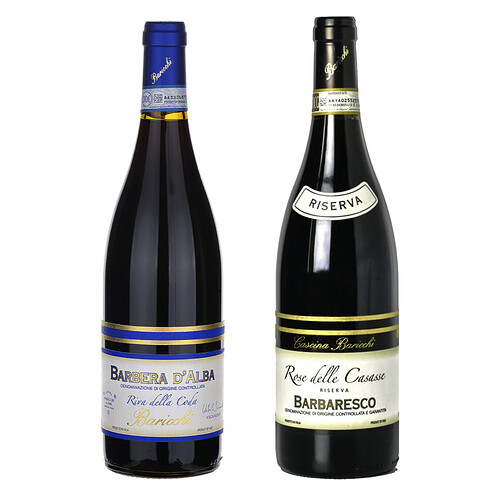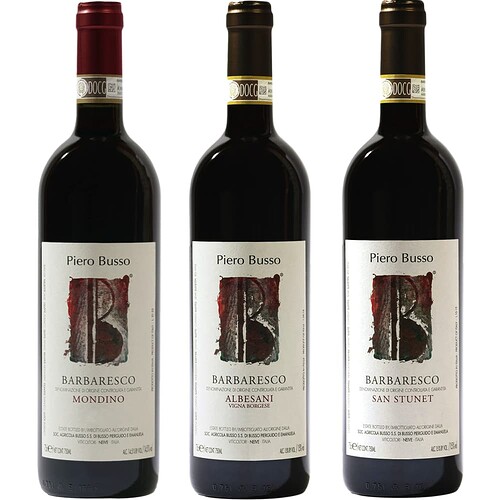Cascina Baricchi:
Barbaresco Riserva “Rose delle Casasse” 2017 95VM
‘Riva della Coda’ Barbera d’Alba 2020 nyr
Piero Busso:
Barbaresco Mondino 2020 92VM
Barbaresco Albesani 2020 nyr
Barbaresco San Stunet 2020 nyr
CASCINA BARICCHI
These wines are not only rare here in the US, but the grape it is made from is extremely rare in the Piemonte hills of Barbaresco and Barolo: Nebbiolo Rose. There is just on other wine known to be made from the grape in it’s entirety: Elvio Cogno’s Barolo Vigna Elena that averages $175 in price. GREAT thread on this grape here and even better here.
There are so many great details below on the Baricchi wines, it is such a great story!
The Rarest Nebbiolo “Variant”
“Nebbiolo Rosé should not be referred to as a “Nebbiolo” (even worse to refer to is as a clone) as it is a distinct variety, though along with Freisa, it’s Nebbiolo’s closest relative” Ian d’Agata. The most unique thing about this wine, besides it being hard to find, is that it is made mostly from 114 year-old vines of a rarely seen variant of the Nebbiolo grape: Nebbiolo Rose. The wine is made from just twenty rows of Nebbiolo Rosé mostly planted in 1913 on a west-facing slope of clay, sand-and-limestone near Neive. Vines this old are almost non-existent in the Langhe, and old Nebbiolo Rosé vines are rarer still, making this is a Barbaresco a truly unique wine.
Nebbiolo Rose was a component of many great Barolos and Barbarescos in decades past, but Nebbiolo Rose suffered from low yields and an even light hue than regular nebbiolo (lampia). But, despite this, the wine more than makes up for this with haunting perfumes and sensual textures. Still, Nebbiolo Rosé all but died out, replaced by Nebbiolo clones that had a higher proclivity for denser fruit sets and deeper color. By the late 1970s, only a handful of producers were still maintaining productive vines of Nebbiolo Rose. One of them was Vietti’s Alfredo Currado in their Barolo Briacca MGA — and the other was Enrico Giovannini-Moresco, whose Barbaresco Podere del Pajoré. The last vintage of these was 1982.
Fortunately, proprietor of Cascina Baricchi, Natale Simonetta, has today emerged as the clone’s great champion. The winemaking here is very traditional, with long macerations and patient aging in neutral barrels (most producers are selling the 2021 vintage). In the cellar, Natale crushes the grapes by foot for the gentlest extraction possible. He then ferments and macerates for 30+ days, using the ultra-traditional capello sommerso for the last couple weeks. That gives the wine its firm structure. To maximize the wine’s expressiveness, Natale gives it three years aging in used 500 to 800-liter barrels, followed by bottling with a minimum of sulfur. (Importer, Rare Wine Co.)
My personal experience with these wines is great, they are classically styled, with fresh red fruits, spices, and loads of the rose petal aromatics that Nebbiolo at its finest should exude in its perfume and palate. On the palate you have the classic acidity but a more moderate tannin structure of a moderately young Nebbiolo.
PIERO BUSSO
The family estate of Piero Busso is a leading name in Barbaresco for its dedication in reflecting the natural elegance of Nebbiolo from Neive.
Piero Busso’s father planted in 1948 by hand the Nebbiolo vines that today wrap around the family’s house and cellar in cru ‘Albesani.’ Now Piero’s son, Pierguido and daughter, Emanuela, work side by side with their father and mother, Lucia, in crafting the family’s wines.
Three of the estate’s four crus – Albesani, Mondino and Gallina — are located in Neive, where Barbaresco’s highest-altitude vineyards are found. The fourth, San Stunet, is in Treiso, at the southern end of the appellation.
What is striking when you taste these Nebbiolo wines is not a “house” style but a symphony of flavors and textures unique to each vineyard. This is not “baby” Barolo, but Barbaresco writ large, standing proudly apart with its suave tannins, silky texture and endless depth. (Importer, North Berkley Imports)

